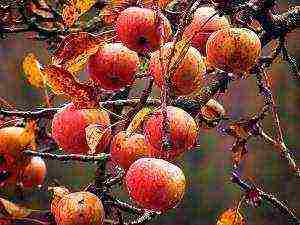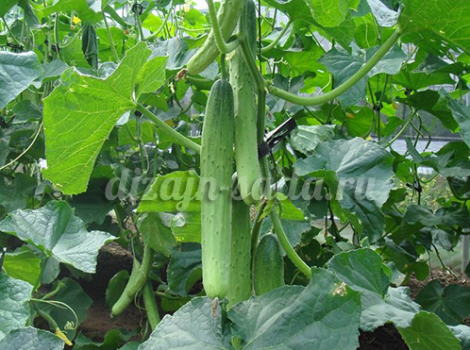Content
- 1 The best varieties of standard roses of different colors
- 2 Pruning standard roses in spring and winter
- 3 How to grow and care for standard roses (with video)
- 4 How to grow a rose on a stem: fertilizers and feeding
- 5 Standard roses in garden landscaping (with photo)
- 6 The most beautiful varieties of standard roses (with photo)
- 7 The best varieties of roses for boles in landscape design
- 8 Top best varieties of standard roses
Representatives of standard roses are not an independent group - the cultivation of these thorny crops on a stem is used for different types of these plants in order to create a bright and at the same time elegant accent in the garden floristic composition. When pruning standard roses in spring and winter, they are guided by the agrotechnical rules applicable to the grafted variety.
Despite the elite form, standard roses are not something out of the ordinary. These are varieties of various groups that are grafted not to the root collar of the stock, but to the shoot, the so-called trunk, that is, to the trunk of a greater or lesser height.
If miniature and climbing roses are grafted onto the stem, they will retain the properties inherent in a particular group. Climbing roses as standard roses by description resemble cascading or "weeping".
The best varieties of standard roses of different colors
Below is a description of the best standard roses in different colors.
Stamp roses "Ingrid Bergman" - hybrid tea rose with medium-sized (35 petals) dark red medium-sized flowers.
Standard roses "Friesia" - a rose from the floribunda group with double bright golden-yellow flowers with a diameter of 6-8 cm.
Standard roses "Cardinal de Richelieu" - a variety from the shrub group. The flowers are double, medium-sized, dark purple in color, fragrant, collected in a brush.
Standard roses "Lily Marlene" - the buds of this hybrid tea rose are almost black in color, the blossoming flowers are dark red, medium-sized, have 25 petals.
Standard roses "Lyons-Rose" - a rose from the floribunda group with large cupped very double flowers. The color of the petals is creamy white, with a yellow-apricot center.
Stamp roses "Lubecker Rothspon" - a rose from the floribunda group with wine-red goblet-shaped flowers.
As you can see in the photo, the flowers of these standard roses are collected in large inflorescences.
Stamp roses "Scarlet Queen Elizabeth" - a rose from the floribunda group with orange-scarlet dense double flowers. The buds are in the form of hybrid tea roses, but the flowers are collected in racemose inflorescences.
Standard roses "Flamingo" - a rose from the floribunda group. The buds are very tall, pointed, light pink, located on single peduncles. Flowers are pale pink, goblet, up to 11 cm in diameter, terry.
Standard roses "Pascali" - hybrid tea rose with creamy white medium-sized (35 petals) not very large flowers. The aroma is weak. The leaves are green, very shiny.
These photos show some standard roses, the description of which is given above:
Pruning standard roses in spring and winter
The rules for spring pruning of standard roses are determined by the group of the grafted variety. These roses differ from spray roses in a brightly outlined and balanced crown silhouette. The long, thin stem can serve as a conduit for the supply of water and nutrients to the plant.
Branching of the bush should begin directly at the grafting site.
Hybrid tea and climbing varieties grafted to the stem are cut to 1-2 buds, that is, shorter than it is customary to do with their usual planting.
The shape of the crown of a standard rose is even more important than the shape of an ordinary rose bush.This means that the upper kidney should be facing upwards. This is the only way to achieve a fluffy, uniform crown of the plant, avoiding the intertwining of shoots or too dense middle.
Cascading weeping roses, in particular, once-flowering varieties, require even more care. Here it is necessary in principle to adhere to the rules of care that apply to climbing roses.
To achieve a weeping crown shape, you do not need to trim anything at all for the first, and most often for the second year after planting. This is relatively easy if you are dealing with Rambler roses, which have soft shoots.
In other varieties, the shoots will have to be tied and directed downward. After modeling the crown, you need to annually remove the old shoots that grow above the graft. If necessary, the old shoot must be trimmed so that only one fresh lateral shoot remains on it.
Lateral shoots should be shortened to 3-4 buds. You will also have to cut off too long shoots that reach the ground.
Watch the video on how to prune a standard rose in spring and winter, which shows all the nuances of this agricultural technique:
How to grow and care for standard roses (with video)
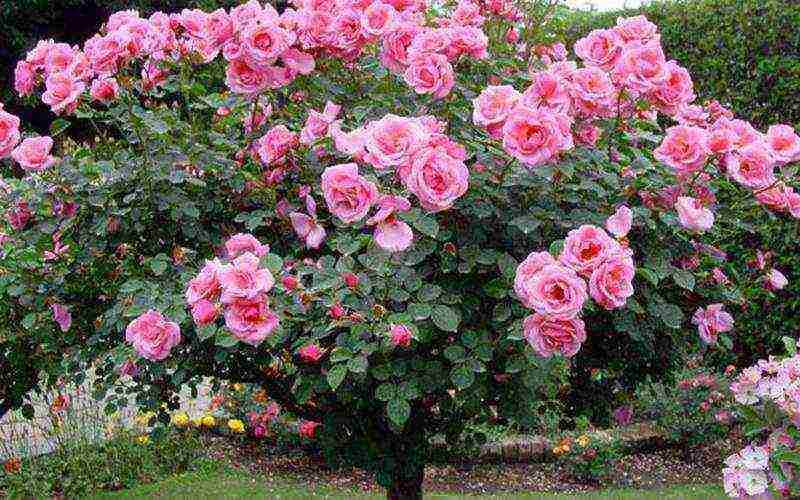
Stamp roses in the photo
Large-flowered, multi-flowered, climbing, re-flowering shrub and miniature species are suitable for the formation of roses in the standard form. In almost every group of roses there are varieties suitable for growing on a trunk.
The height of the trunk can be different - from 80 cm for a large-flowered rose to 125 cm for a climbing one. Climbing roses form weeping standard forms. The crown and trunk of a standard rose are, respectively, a scion and a stock. The varietal graft is grafted onto the stock at least three times to create a beautiful and correct crown of the standard rose.
Standard roses in landscape design look very good in a small amateur garden, they create a pleasant romantic atmosphere.
All standard roses must be tied to pegs. It is not easy to plant and grow a standard rose, as practice shows, therefore they are more expensive than ordinary bush forms. Caring for standard roses should be skillful, including mandatory pruning and protection of the grafting site in the winter cold.
During cultivation, most standard roses are pruned like shrub roses. Weeping standard roses are climbing varieties grafted onto a rosehip at a height of about 1.5 m. In the spring, old shoots are completely removed from them, and young ones are shortened by a third. If this is not done, they will become too long and the bush will lose its shape.
When growing seedlings of standard roses in the garden, the main thing is to get an even and strong stem from rose hips! The higher it is, the better. It is not difficult to grow a rosehip for a stock itself if you know a number of features. Here they are: for sowing, rose hips must be harvested brown in mid-August, the seeds are isolated from them and immediately sown into moist soil without stratification. In dry weather, crops are watered. In the spring, the dog rose grows together and grows until the fall. From fully ripe rose hips, seedlings will appear only in the second spring.
In the fall, after leaf fall, dog rose seedlings are dug up, sorted, the largest are selected and planted according to the 150 × 20 cm scheme. Wide aisles are made so that there will be enough land for hilling the eyepieces for the winter.
Rosehips are grown for 4 years. All this time it is watered, loosened, sprayed from diseases and pests. In the 5th year from the root, it gives strong even shoots of renewal, and then all lateral branches are removed, except for one best shoot, which at the end of July, upon reaching 1.5-2 m, is pinched for lignification.
In mid-August, the stock is oculated with different varieties of 4-5 buds, each at a height of 120-150 cm. Each branch on the stem is oculated at the base. The bushes grown from these buds branch better and are not so much broken by the summer winds as those that grew from the buds grafted on the trunk itself.
Good weeping saplings are obtained from polyanthus and ground cover roses with thin, flexible shoots that fall to the ground. They are very disease resistant and winter well.
After the leaves have fallen on the dog rose in the fall, the stems of the eyepieces are tilted along a row, tying them at the soil surface to the bases of other stems, and sprinkled with earth from the rows.
In the spring, the plants are opened, they are tied to the installed supports of two wires along the row, like in a vineyard. The rose hips are cut to the bud, and by the fall, well-developed seedlings grow.
In total, in order to grow a rose in standard form, starting from rosehip seeds, it takes 7 years. In a permanent place, such roses are planted at a distance of 120 cm from each other, and weeping forms - 180 cm.
It is good to use bamboo stakes for support, they are durable and beautiful.
When planting standard roses, keep in mind that for the winter they will have to be tilted to the ground and covered, provide a place for this.
The soil around the boles must be mulched with humus, chopped straw or sawdust to retain moisture, because the bare soil dries out quickly. Water and loosen the soil under standard roses more often than under ordinary spray roses. It is necessary to water, not allowing water to get on the leaves, that is, not by sprinkling, but by letting the trunk circle into the hole. Drops of moisture on the leaves, especially in the second half of summer, contribute to the intensive development of fungal diseases.
Watch the video on how to grow a standard rose to better understand how such a plant is formed:
How to grow a rose on a trunk: fertilizers and feeding
Standard roses are fertilized annually, and more than once. In the spring, after pruning, mineral fertilizers are applied to the soil with a predominance of nitrogen fertilizers along with humus. Humus leaf land is taken from old forest belts, removing the top layer up to 10 cm thick. This is an excellent soil for other cultivated plants, it is formed from rotted leaves and branches of woody plants.
As you can see in the photo, when caring for standard roses, soil fertilizer mixtures are used, which are purchased in specialized stores, the doses of their use are indicated on the packages:
In the process of caring for standard roses, it is better to time fertilizing with the phases of development of roses:
- after the first flowering;
- after the second flowering (complex mineral fertilizers alternate with mullein infusion);
- after the third flowering in late summer - early autumn (potassium-phosphorus fertilizers are good).
During the summer, foliar dressing is necessary with solutions of Kemira Lux, Solution, potassium humate alternately. "Solution" and "Kemir lux" contain nitrogen, phosphorus, potassium, magnesium and microelements: boron, copper, iron, manganese, molybdenum, zinc. These substances give not only good growth and development of standard roses, but also partially protect them from diseases.
One of the features of growing standard forms of roses is the need for regular spraying. This is done in the morning after the dew dries or in the evening with a solution at a concentration of 1 g per 1 liter of water. Ordinary bush roses can also be treated with these fertilizers.
Standard roses in garden landscaping (with photo)
Standard roses in garden design will adorn any site. With dangling flowering shoots, they look great against a green lawn or blue sky, as well as in combination with low bush or ground cover roses planted between them.
Standard roses with a dark color of flowers are well planted between white, yellow and light pink varieties. Cream or white roses are planted with orange varieties. It is better to place two-four-color trunks separately.
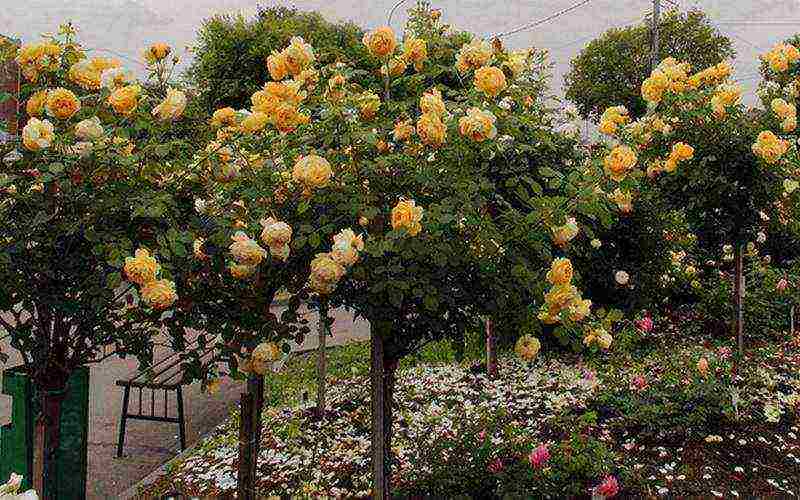
Rose variety "Gloria Day" in the photo
The old, but eternal grade "Gloria Day" looks very impressive at the height.
On a trunk 90 cm high, its flowers are located at the level of the spectators' faces. A similar variety was not bred before her and is unlikely to be bred after. On boles, its large flowers look even more graceful than on bush roses.
Until recently, there was no single classification of roses on a stem used in landscape design. Now the world standard has been adopted: low-stemmed - 60 cm, medium-stemmed - 90 cm and high-stemmed - 140 cm. Miniature roses are grafted onto stems 60 cm high, tea-hybrid and polyanthus 90 cm, and climbing cascade forms on high (140 cm).
Single-color plantings of standard roses are boring, there are long breaks in flowering. It is better to plant stems on which several varieties are grafted: the upper ones are ordinary bush, the lower ones are weeping forms. After planting, for better survival, the boles are whitewashed, they do not overheat in the sun and are less affected by diseases.
See how the standard roses look spectacular in landscape design in these photos:
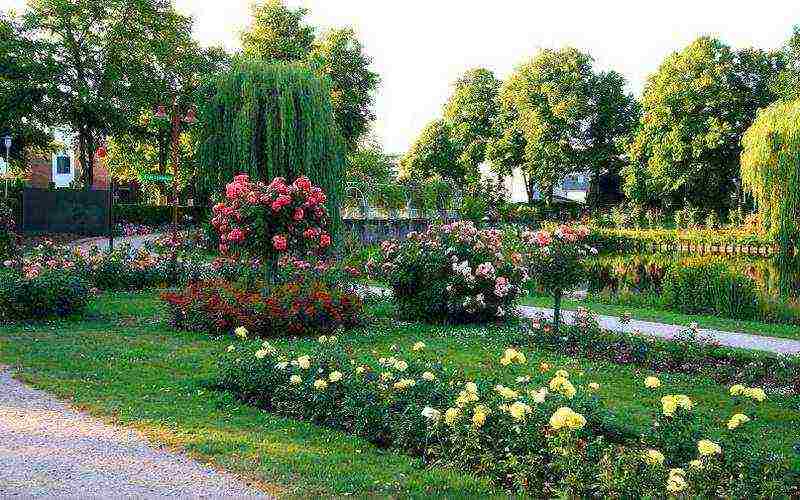


The most beautiful varieties of standard roses (with photo)
The most beautiful varieties of standard roses grown in the middle lane are described below.
"Iceberg", or "Schneevitchen" - floribunda rose with pinkish buds and pure white double (30-40 petals) flowers up to 7 cm in diameter. Very abundant flowering. The leaves are green, very shiny. The bush is vigorous, up to 1 m high.
Ingrid Bergman - hybrid tea rose with medium-sized (35 petals) dark red medium-sized flowers. In culture since 1985. The flowers are fragrant, the flowering is profuse. The leaves are dark green, highly shiny. The advantages of this one of the best varieties of roses on a stem are winter hardiness and high resistance to diseases.
"Cardinal de Richelieu" - a rose from the shrub group. The flowers are double, medium-sized, dark purple in color, fragrant, collected in a brush. Flowering continues for a month. The dark green leathery leaves are numerous, the shoots are almost without thorns. The bush is compact, up to 1.2 m high. The advantages of the variety are winter hardiness and high resistance to diseases.
Lily Marlene - the buds of this hybrid tea rose are almost black in color, the blossoming flowers are dark red, medium-sized, have 25 petals. The aroma is weak. The leaves are shiny, green with a bronze sheen. The bush is vigorous, up to 80 cm high. The advantages include the resistance of flowers to rain and sun, the disadvantages are weak resistance to diseases.

Stamp roses "Lyons-Rose" in the photo
Lyons-Rose - floribunda rose with large cupped very double flowers. The color of the petals is creamy white, with a yellow-apricot center.
Pay attention to the photo - this variety of standard roses has flowers collected in inflorescences of 3-5 pieces:
Flowering is profuse and long lasting. Has a pleasant aroma. The foliage is green, dense. The bushes are medium-sized. The dignity of the variety is high frost resistance.
Lubecker Rothspon - floribunda rose with wine-red goblet-shaped flowers. Flowers are collected in large inflorescences. Blooms very profusely until frost. The leaves are dark green, shiny. The bush is up to 60 cm high, the shoots are straight.
The best varieties of roses for boles in landscape design
"Pascali" - hybrid tea rose with creamy white medium-sized (35 petals) not very large flowers. The aroma is weak. The leaves are green, very shiny. Vigorous bush, 110 cm high, straight shoots. The advantages of the variety are winter hardiness and resistance to rain.
"Scarlet Queen Elizabeth" - floribunda rose with orange-scarlet double flowers. The buds are shaped like hybrid tea roses, but the flowers are collected in racemose inflorescences. Differs in very long flowering. This one of the best varieties of roses for boles has bronze-green leaves, shiny. Vigorous bush, up to 120 cm high. Shoots are straight.
"Flamingo" - a rose from the floribunda group. The buds are very tall, pointed, light pink, located on single peduncles. Flowers are pale pink, goblet, up to 11 cm in diameter, double (25 petals). Abundant flowering. The leaves are dark green, glossy, the shoots are covered with large frequent thorns. The advantages include frost resistance, the disadvantages - instability to damage by powdery mildew.
"Friesia", or "Corresia", or "Sunsprite" - floribunda rose with double (25 petals) bright golden-yellow flowers with a diameter of 6-8 cm. The flowering is very long. The aroma is weak. This variety of standard roses has green leaves, very shiny. The bush is moderately vigorous, 70-80 cm high.
Popular varieties from the tea hybrid group are also used.
Gloria Day, from the floribunda group
"Samba",
from the group of polyanthus - Fairy.
Rate the article:
(2 votes, average: 1 out of 5)
Many summer residents dream of growing a luxurious pink "tree" in their garden. And only a few of them dare to make their dream come true: the idea of growing an elegant rose on a stem in our rather harsh climate seems too adventurous. However, if you choose the right stem and scion variety, it will not be so difficult to form a pink "tree".
You are deeply mistaken if you think that growing a rose on a stem is the lot of professionals. Of course, to form a pink "tree" is not to weed out a flower bed, however, with patience, you can achieve significant success in this troublesome business even without being an advanced gardener.
If you have experience in grafting garden trees, then you will certainly cope with the formation of a standard rose, because this plant is nothing more than the result of budding (grafting with a bud) of a cultivated rose on a rosehip branch.
How to grow a standard rose yourself
The best time for budding rose hips is the period of active sap flow, when the bark is well separated: late April - early May or late July - early August.
An ideal stock will be a strong branch (it will later become the “stem” (stem) of the rose “tree”) of a rose hip, which is not afraid of frost, resistant to diseases and pests, and has a powerful root system. All other branches should be cut before grafting.
It is better to harvest cuttings (shoots with mature wood and well-formed buds) for grafting on the eve of the procedure. Once cut, wrap them in a damp cloth and leave them on the bottom shelf of the refrigerator overnight.
The stem can be inoculated (inoculated with a high-quality scion bud) at a height of 40 cm to 1.5 m above ground level. The final choice of the grafting site depends only on how tall the standard rose you want to get as a result.
After 2-3 weeks after the procedure, evaluate whether the fusion was successful or not. If the grafted bud begins to swell, and the leaf petiole falls off, then budding was successful. In this case, loosen the harness a little, and after 3-4 weeks remove it altogether.
A blackened "eye" is evidence of an unsuccessful vaccination, but not a reason for frustration, because after removing the binding and treating the wounds on the trunk, the procedure can be repeated in another place.
Next spring, cut the branch of the rose hips so that 4-5 cm of the stem remains above the established bud.
To make the process of forming a standard rose go faster, do not forget to timely remove wild growth on the stem and roots, as well as feed the plant (the choice of top dressing depends only on the composition of the soil).
You will be able to admire the pink "tree" grown by your own hands 2-3 years after the rosehip grafting, when the branches of the grafted cultivar will grow well.
Recommended varieties of roses for grafting on a stem
In principle, any roses that are compatible with the stock can be used as a scion to form a rose "tree". However, if you want to get a plant of an unusual shape and unearthly beauty, give preference to a variety that blooms profusely and beautifully.
The height of the scion should be taken into account when choosing the height of the rootstock. So, miniature roses will look good on a low (up to 0.7 m) trunk. The optimal stem height for grandiflora, hybrid tea, polyanthus and ground cover roses is 0.7-1.2 m; for climbing - 1-2.5 m.
We bring to your attention 7 varieties of roses, which at the time of budding are a magnificent sight and not only tolerate our harsh winters well, but are also resistant to diseases and pests.
Knirps
For decorating small gardens, creating flower beds, microborders, Knirps varieties grown on a trunk are ideal. Plants bloom profusely and for a long time. Their luxuriant double pink flowers against the background of small rich green foliage are the embodiment of tenderness and defenselessness.
However, despite the apparent fragility, plants adapt perfectly to the conditions of our rather unpredictable climate. They tolerate heat and severe frosts well, they also do not care about prolonged rains.
Another advantage of Knirps roses is their good resistance to diseases and pests.
| Type of rose | Boom height (cm) | Bloom | Flower size (cm) | Scent | Winter hardiness | Disease resistance |
| groundcover | 70-120 | continuous, from June to October | 3-4 | weak | average | average |
Claude Monet
Claude Monet's pink "tree" will win your heart with an unusually bright, but not flashy color of the petals. Only recently blossoming flowers have such a lemon-yellow color with red blotches, towards the end of flowering they become creamy pink.
The semi-open flowers exude a complex citrus aroma with hints of vanilla.
Plants are moderately resistant to powdery mildew and black spot, winter well. But during prolonged rains, these "trees" do not feel well: their buds begin to rot.
| Type of rose | Boom height (cm) | Bloom | Flower size (cm) | Scent | Winter hardiness | Disease resistance |
| tea-hybrid | 70-120 | abundant from June to the end of September |
8-9 | strong | average | average |
Leonardo da Vinci
According to experienced rose growers, Leonardo da Vinci's floribunda is one of the best representatives of the Rosehip genus. This variety is not susceptible to diseases, it tolerates rainy weather well, and it is not afraid of frosts. However, in order not to know the problems with growing this plant, it is better to choose areas protected from the wind as a planting site.
The main advantage of the standard roses of the Leonardo da Vinci variety is their incredibly beautiful flowers. Lush, rich pink buds in the shape of a rosette bloom for a very long time (2-3 weeks), exuding a light, subtle aroma.
Roses of the Leonardo da Vinci variety are self-sufficient plants, but they will look great in group plantings. When choosing companions for them, give preference to plants with blue or white flowers.
| Type of rose | Boom height (cm) | Bloom | Flower size (cm) | Scent | Winter hardiness | Disease resistance |
| floribunda | 70-80 | abundant, from July to September | 8-10 | weak | high | high |
New Dawn
Bushes of standard New Dawn roses are distinguished by their endurance and vigorous growth, the plants perfectly adapt to the vagaries of the weather and are not afraid of 30-degree frosts or high temperatures. The only disease that can threaten them is powdery mildew. However, timely preventive measures will allow you to save the pink "tree" from this misfortune.
New Dawn roses do well in partial shade. If you want to achieve abundant flowering and fully enjoy the beauty of silvery cream flowers, choose a stem in a well-lit area of the site. When the sun's rays hit the plant, its buds will, as it were, "emit" light.
These climbing roses can be used to decorate walls, fences. They will also look interesting as an independent element of landscape design.
|
|
||||||
| Type of rose | Boom height (cm) | Bloom | Flower size (cm) | Scent | Winter hardiness | Disease resistance |
| climbing | 100-250 | abundant, continuous, from June to the first frost | 8-9 | strong | high | high |
Paul Noel
Bole-grown Paul Noel roses with long, graceful, flexible shoots look luxurious! That is why these plants are often used to create decorative arches, as well as decorate gazebos.
Bright coral pink flowers with a strong apple scent appear on last year's shoots. You can admire the second wave of flowering (less abundant than the first) at the end of summer.
The bushes are moderately resistant to powdery mildew and tend to overwinter well.
| Type of rose | Boom height (cm) | Bloom | Flower size (cm) | Scent | Winter hardiness | Disease resistance |
| climbing | 100-250 | the first wave - in June, the second - in August, throughout the summer - single flowers | 4-5 | strong | average | average |
Super Excelsa
These climbing roses are considered among the most suitable for growing in the middle lane. They are resistant to pests and diseases (with the exception of powdery mildew), they are not afraid of either prolonged heat or rain with showers. Well-covered plants can tolerate even 30-degree frost perfectly.
Long light green shoots with small but very lush bright crimson flowers, collected in large inflorescences, will be a great decoration for one of the walls of the house. If desired, they can also be run along a hedge or on an old tree.
| Type of rose | Boom height (cm) | Bloom | Flower size (cm) | Scent | Winter hardiness | Disease resistance |
| climbing | 100-250 | abundant, from June to September | 3-4 | weak | high | high |
Schneewittchen
The plant fully and completely justifies its name: in translation from the German language Schneewittchen - Snow White. Lush, dazzling white flowers, collected in large inflorescences, resemble clouds and exude the finest honey aroma.
The bushes are extremely frost-resistant and not afraid of the heat. These roses also tolerate high humidity well. However, during the rainy season, small pink spots may appear on the flowers.
Standard roses of the Schneevitchen variety can be used to create a hedge, as well as an element of mixed plantings. However, in order to prevent black spot and powdery mildew, planting these roses too close to other plants is still not worth it.
| Type of rose | Boom height (cm) | Bloom | Flower size (cm) | Scent | Winter hardiness | Disease resistance |
| floribunda | 70-120 | abundant, from July to October | 6-7 | weak | high | average |
***
If you find it difficult to make a choice in favor of this or that variety, plant 2-3 varieties of roses on one stem! Before you start implementing this experiment, be sure to make sure that the roses of the selected varieties are compatible with each other in color, growth strength and flowering time.
Good luck!
Ant ale
 The best varieties of standard roses are the decoration of any site. Standard roses are becoming more and more popular these days. They are simply amazing with their beauty. Their main advantage is their graceful appearance, long abundant flowering, favorable wintering and resistance to various diseases. Moreover, they are absolutely not capricious.
The best varieties of standard roses are the decoration of any site. Standard roses are becoming more and more popular these days. They are simply amazing with their beauty. Their main advantage is their graceful appearance, long abundant flowering, favorable wintering and resistance to various diseases. Moreover, they are absolutely not capricious.
Top best varieties of standard roses
According to legend, the first standard rose was bred by the royal gardener in the 18th century, the royal gardener for the ladies of the court. With such flowers, they enjoyed the scent of a rose without bending over. Now there are many varieties of beautiful roses on the tree, which delight in color and aroma.
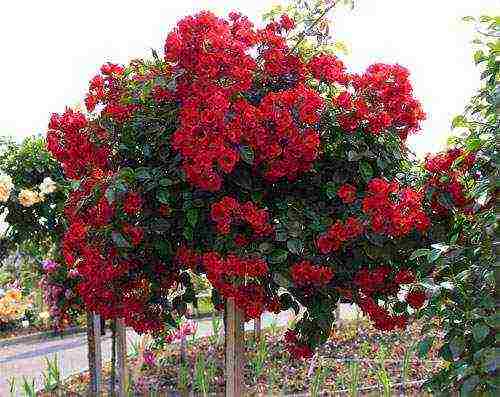
Scarlet Mayandecor
Scarlet Mayandecor is the ideal standard rose. She is able to adapt to different conditions, is distinguished by endurance, resistance to diseases. It does not need to be cut when the flowers are dry. The variety is distinguished by its vigor of growth. The flowers of the plant are small, 3-4 cm in diameter, have bright red wavy petals. It grows as a fountain-shaped round bush. Due to its lush flowers, the beauty's leaves are not visible.
It pleases with its continuous flowering in summer and autumn.To obtain this type, budding is needed into the trunk with 2-3 buds in different directions.
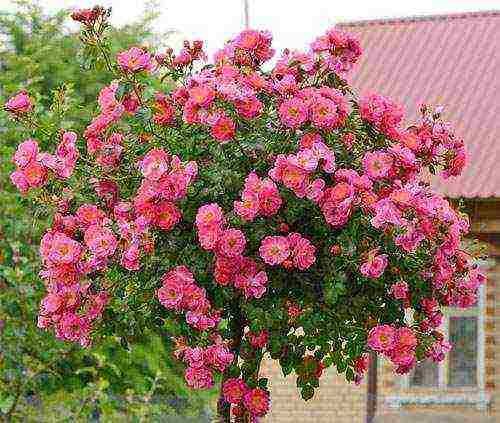
Magic Mayandecor
The Magic Mayandecor ground cover rose is very beautiful. It is characterized by multiple flowering. Has a delicate hawthorn scent. To breed the variety, grafting into the root collar is required.
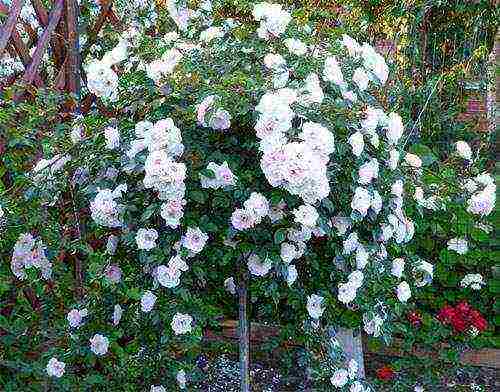
Ice Mayandecor
The Ice Mayandecor rose is striking with its amazing beauty. She has beautiful white double flowers. It grows profusely. Reaches a height of 140-170 cm. Looks perfect at the porch.
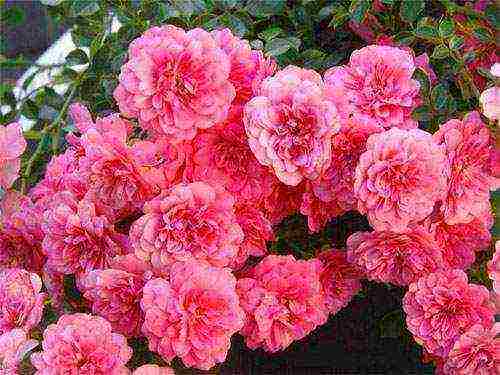
rose knirps
An ideal solution for a small garden would be the Knirps rose. She is compact and beautiful. Does not exceed 30 cm in length. It has graceful small flowers 3-4 cm with thick double petals on a stem with shiny green leaves. The plant looks great in a flower garden.
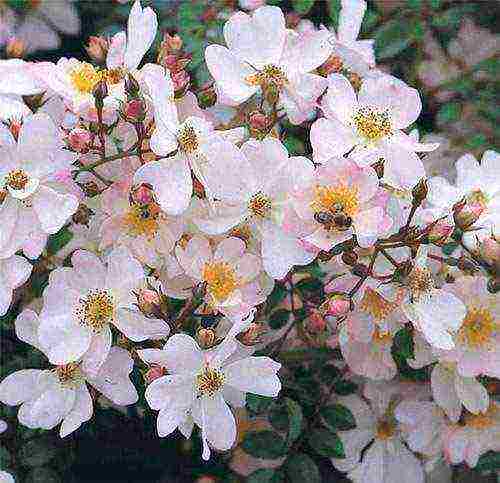
Immensee
For a single accent in the garden, it is recommended to plant an Immensee ground cover rose. It looks like a lace bouquet. Small light pink flowers grow in clusters and turn white at the end of the season.

rose Catherine Deneuve
A rose with a rare light orange color Catherine Deneuve will look no less successful in a small area. She is not only beautiful, but also not afraid of frost.
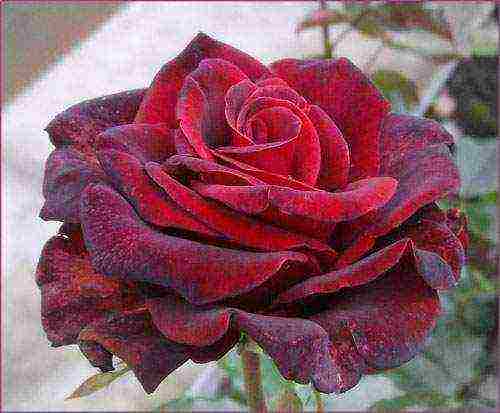
Marcel Pagnol
A blood-red rose with velvety petals, Marcel Pagnol beckons with its scent. The bush turns out to be large and is well suited for small spaces.
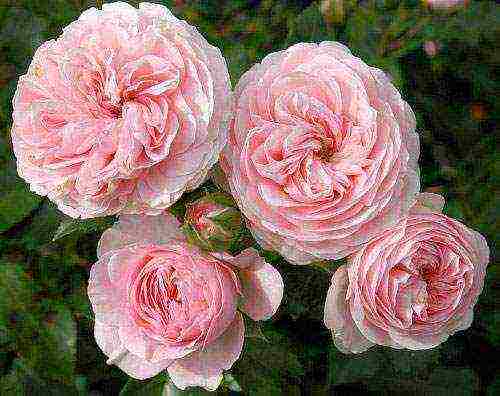
Larissa
Unpretentious roses of the Larissa variety, bloom profusely. The bush is round and very neat, the flowers are pale pink.
A winning option for a large garden would be a rose. New Down with a spreading volumetric crown. This is one of the most popular varieties of roses. The rose gained its popularity thanks to its silvery pink flowers with semi-double petals. Hardy, not afraid of diseases.
Stamper Frisia yellow has a golden hue. Lives well next to perennial plants.
Among the roses blooming in a cascade, an elegant variety can be distinguished Paul Noel... It has very fragrant coral-red flowers 5-6 cm in size. It grows in small clusters.
Rose looks amazing Alba Meidiland with snow-white flowers. Lovers of original colors will love the rose variety Leverkusen... They immediately draw attention to her thanks to the yellow colors.
Read also The best varieties of roses for the Russian climate
Dzyuban Tatiana
